2007 CHEVROLET TRAIL BLAZER service schedule
[x] Cancel search: service schedulePage 215 of 574
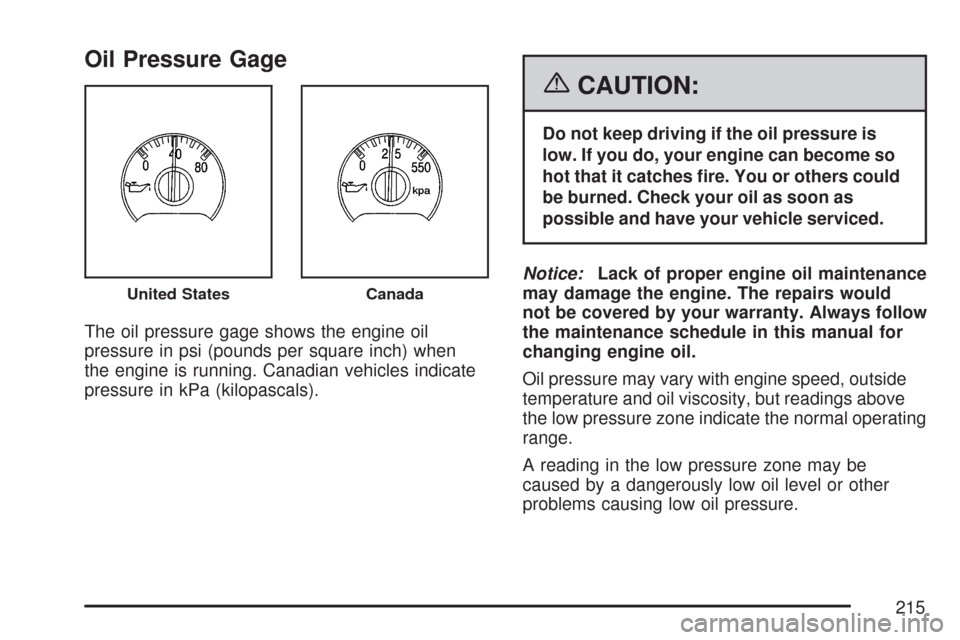
Oil Pressure Gage
The oil pressure gage shows the engine oil
pressure in psi (pounds per square inch) when
the engine is running. Canadian vehicles indicate
pressure in kPa (kilopascals).
{CAUTION:
Do not keep driving if the oil pressure is
low. If you do, your engine can become so
hot that it catches �re. You or others could
be burned. Check your oil as soon as
possible and have your vehicle serviced.
Notice:Lack of proper engine oil maintenance
may damage the engine. The repairs would
not be covered by your warranty. Always follow
the maintenance schedule in this manual for
changing engine oil.
Oil pressure may vary with engine speed, outside
temperature and oil viscosity, but readings above
the low pressure zone indicate the normal operating
range.
A reading in the low pressure zone may be
caused by a dangerously low oil level or other
problems causing low oil pressure.
United StatesCanada
215
Page 225 of 574
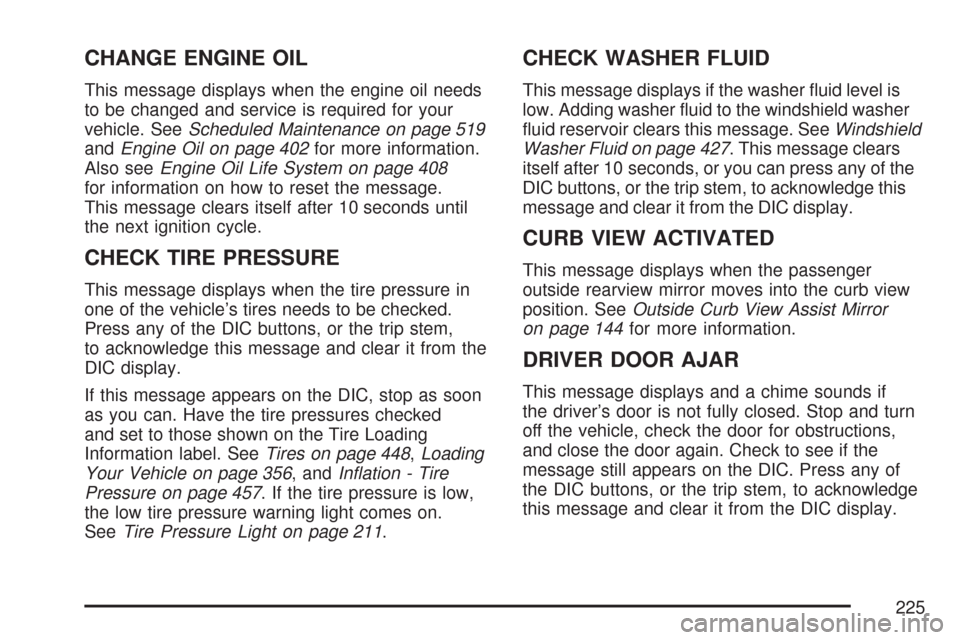
CHANGE ENGINE OIL
This message displays when the engine oil needs
to be changed and service is required for your
vehicle. SeeScheduled Maintenance on page 519
andEngine Oil on page 402for more information.
Also seeEngine Oil Life System on page 408
for information on how to reset the message.
This message clears itself after 10 seconds until
the next ignition cycle.
CHECK TIRE PRESSURE
This message displays when the tire pressure in
one of the vehicle’s tires needs to be checked.
Press any of the DIC buttons, or the trip stem,
to acknowledge this message and clear it from the
DIC display.
If this message appears on the DIC, stop as soon
as you can. Have the tire pressures checked
and set to those shown on the Tire Loading
Information label. SeeTires on page 448,Loading
Your Vehicle on page 356, andIn�ation - Tire
Pressure on page 457. If the tire pressure is low,
the low tire pressure warning light comes on.
SeeTire Pressure Light on page 211.
CHECK WASHER FLUID
This message displays if the washer �uid level is
low. Adding washer �uid to the windshield washer
�uid reservoir clears this message. SeeWindshield
Washer Fluid on page 427. This message clears
itself after 10 seconds, or you can press any of the
DIC buttons, or the trip stem, to acknowledge this
message and clear it from the DIC display.
CURB VIEW ACTIVATED
This message displays when the passenger
outside rearview mirror moves into the curb view
position. SeeOutside Curb View Assist Mirror
on page 144for more information.
DRIVER DOOR AJAR
This message displays and a chime sounds if
the driver’s door is not fully closed. Stop and turn
off the vehicle, check the door for obstructions,
and close the door again. Check to see if the
message still appears on the DIC. Press any of
the DIC buttons, or the trip stem, to acknowledge
this message and clear it from the DIC display.
225
Page 338 of 574
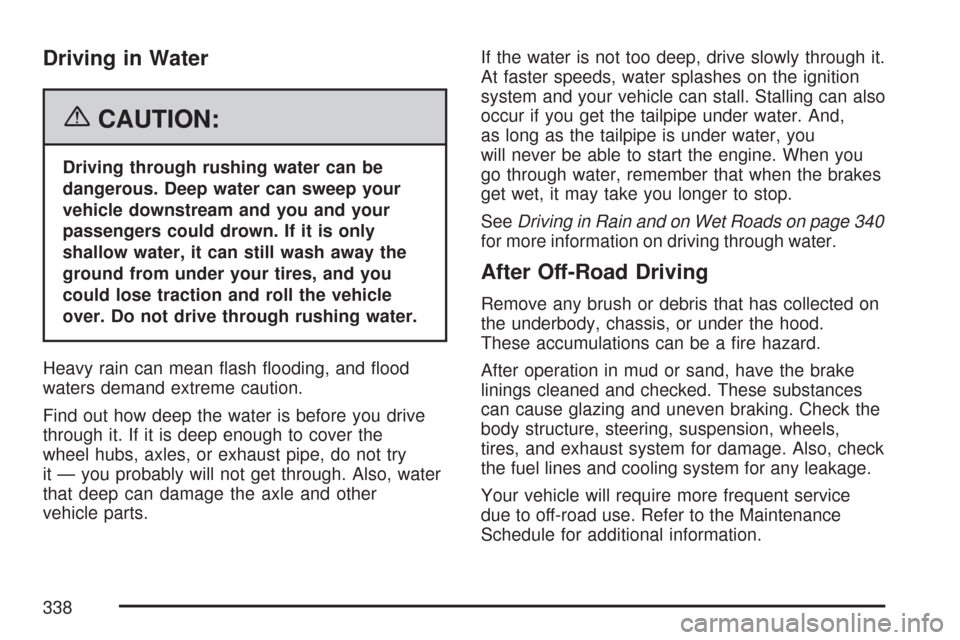
Driving in Water
{CAUTION:
Driving through rushing water can be
dangerous. Deep water can sweep your
vehicle downstream and you and your
passengers could drown. If it is only
shallow water, it can still wash away the
ground from under your tires, and you
could lose traction and roll the vehicle
over. Do not drive through rushing water.
Heavy rain can mean �ash �ooding, and �ood
waters demand extreme caution.
Find out how deep the water is before you drive
through it. If it is deep enough to cover the
wheel hubs, axles, or exhaust pipe, do not try
it — you probably will not get through. Also, water
that deep can damage the axle and other
vehicle parts.If the water is not too deep, drive slowly through it.
At faster speeds, water splashes on the ignition
system and your vehicle can stall. Stalling can also
occur if you get the tailpipe under water. And,
as long as the tailpipe is under water, you
will never be able to start the engine. When you
go through water, remember that when the brakes
get wet, it may take you longer to stop.
SeeDriving in Rain and on Wet Roads on page 340
for more information on driving through water.
After Off-Road Driving
Remove any brush or debris that has collected on
the underbody, chassis, or under the hood.
These accumulations can be a �re hazard.
After operation in mud or sand, have the brake
linings cleaned and checked. These substances
can cause glazing and uneven braking. Check the
body structure, steering, suspension, wheels,
tires, and exhaust system for damage. Also, check
the fuel lines and cooling system for any leakage.
Your vehicle will require more frequent service
due to off-road use. Refer to the Maintenance
Schedule for additional information.
338
Page 380 of 574
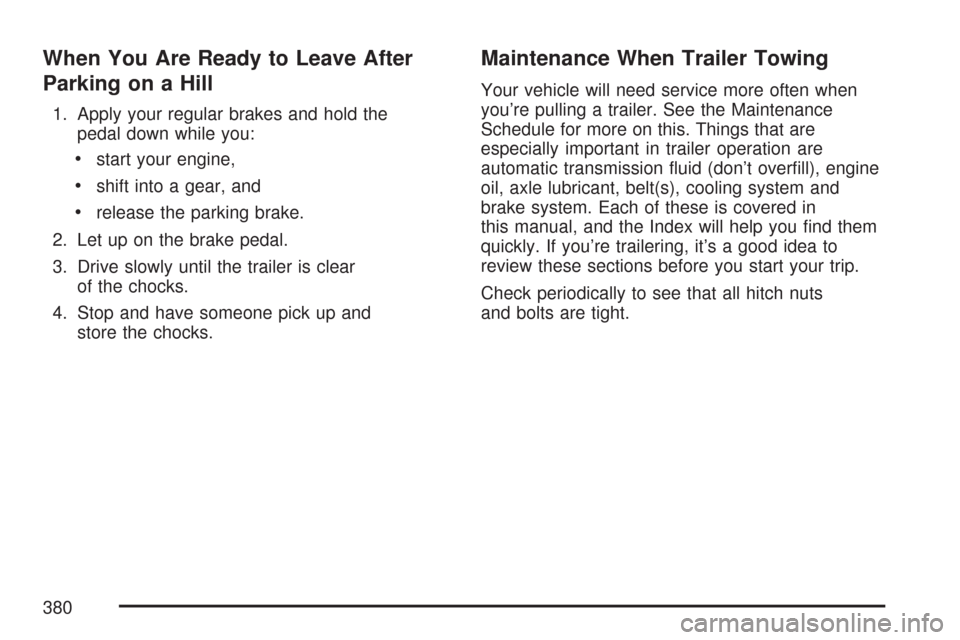
When You Are Ready to Leave After
Parking on a Hill
1. Apply your regular brakes and hold the
pedal down while you:
start your engine,
shift into a gear, and
release the parking brake.
2. Let up on the brake pedal.
3. Drive slowly until the trailer is clear
of the chocks.
4. Stop and have someone pick up and
store the chocks.
Maintenance When Trailer Towing
Your vehicle will need service more often when
you’re pulling a trailer. See the Maintenance
Schedule for more on this. Things that are
especially important in trailer operation are
automatic transmission �uid (don’t over�ll), engine
oil, axle lubricant, belt(s), cooling system and
brake system. Each of these is covered in
this manual, and the Index will help you �nd them
quickly. If you’re trailering, it’s a good idea to
review these sections before you start your trip.
Check periodically to see that all hitch nuts
and bolts are tight.
380
Page 464 of 574
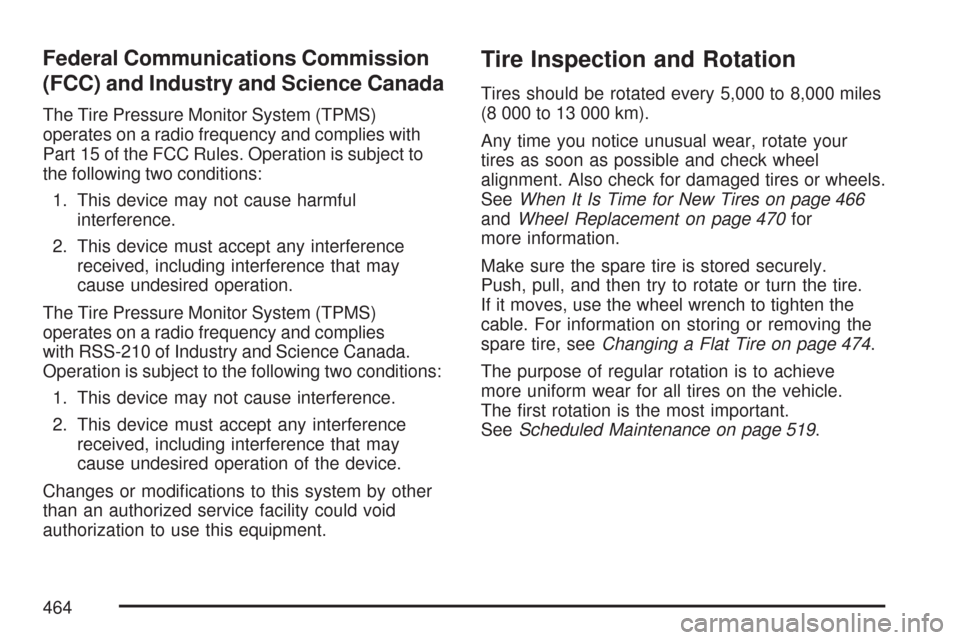
Federal Communications Commission
(FCC) and Industry and Science Canada
The Tire Pressure Monitor System (TPMS)
operates on a radio frequency and complies with
Part 15 of the FCC Rules. Operation is subject to
the following two conditions:
1. This device may not cause harmful
interference.
2. This device must accept any interference
received, including interference that may
cause undesired operation.
The Tire Pressure Monitor System (TPMS)
operates on a radio frequency and complies
with RSS-210 of Industry and Science Canada.
Operation is subject to the following two conditions:
1. This device may not cause interference.
2. This device must accept any interference
received, including interference that may
cause undesired operation of the device.
Changes or modi�cations to this system by other
than an authorized service facility could void
authorization to use this equipment.
Tire Inspection and Rotation
Tires should be rotated every 5,000 to 8,000 miles
(8 000 to 13 000 km).
Any time you notice unusual wear, rotate your
tires as soon as possible and check wheel
alignment. Also check for damaged tires or wheels.
SeeWhen It Is Time for New Tires on page 466
andWheel Replacement on page 470for
more information.
Make sure the spare tire is stored securely.
Push, pull, and then try to rotate or turn the tire.
If it moves, use the wheel wrench to tighten the
cable. For information on storing or removing the
spare tire, seeChanging a Flat Tire on page 474.
The purpose of regular rotation is to achieve
more uniform wear for all tires on the vehicle.
The �rst rotation is the most important.
SeeScheduled Maintenance on page 519.
464
Page 515 of 574
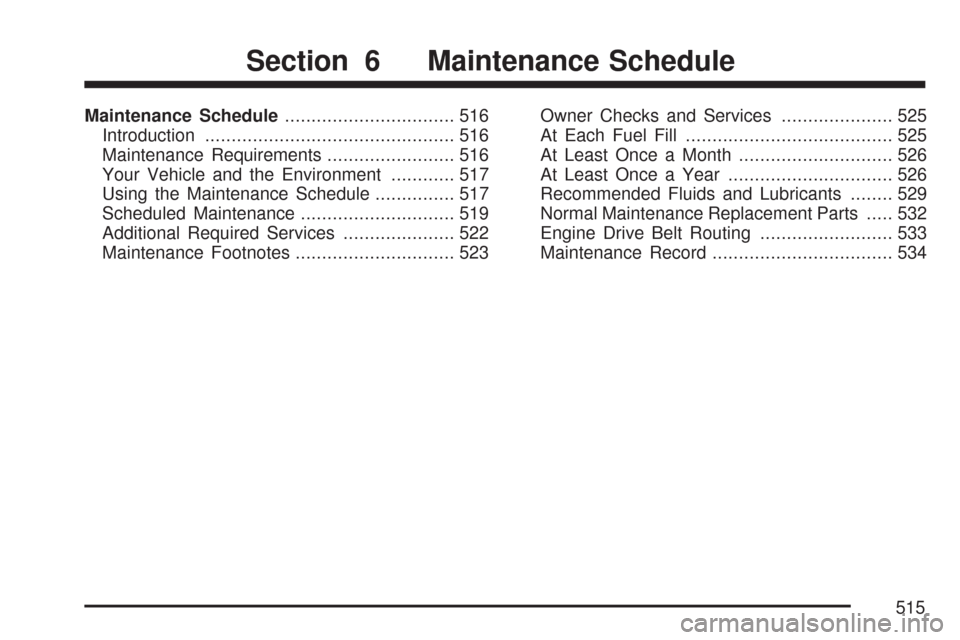
Maintenance Schedule................................ 516
Introduction............................................... 516
Maintenance Requirements........................ 516
Your Vehicle and the Environment............ 517
Using the Maintenance Schedule............... 517
Scheduled Maintenance............................. 519
Additional Required Services..................... 522
Maintenance Footnotes.............................. 523Owner Checks and Services..................... 525
At Each Fuel Fill....................................... 525
At Least Once a Month............................. 526
At Least Once a Year............................... 526
Recommended Fluids and Lubricants........ 529
Normal Maintenance Replacement Parts..... 532
Engine Drive Belt Routing......................... 533
Maintenance Record.................................. 534
Section 6 Maintenance Schedule
515
Page 518 of 574
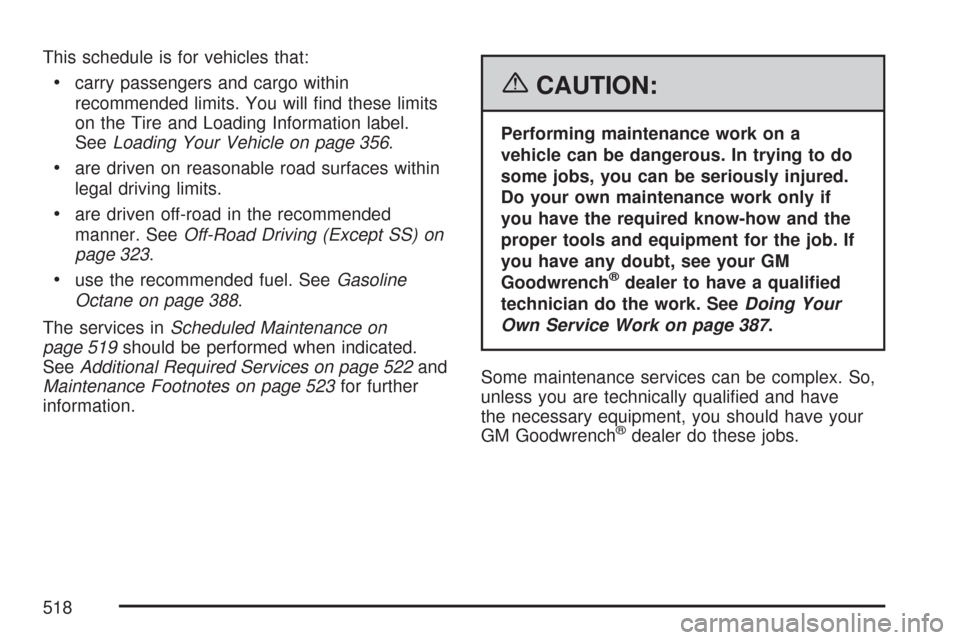
This schedule is for vehicles that:
carry passengers and cargo within
recommended limits. You will �nd these limits
on the Tire and Loading Information label.
SeeLoading Your Vehicle on page 356.
are driven on reasonable road surfaces within
legal driving limits.
are driven off-road in the recommended
manner. SeeOff-Road Driving (Except SS) on
page 323.
use the recommended fuel. SeeGasoline
Octane on page 388.
The services inScheduled Maintenance on
page 519should be performed when indicated.
SeeAdditional Required Services on page 522and
Maintenance Footnotes on page 523for further
information.
{CAUTION:
Performing maintenance work on a
vehicle can be dangerous. In trying to do
some jobs, you can be seriously injured.
Do your own maintenance work only if
you have the required know-how and the
proper tools and equipment for the job. If
you have any doubt, see your GM
Goodwrench
®dealer to have a quali�ed
technician do the work. SeeDoing Your
Own Service Work on page 387.
Some maintenance services can be complex. So,
unless you are technically quali�ed and have
the necessary equipment, you should have your
GM Goodwrench
®dealer do these jobs.
518
Page 519 of 574
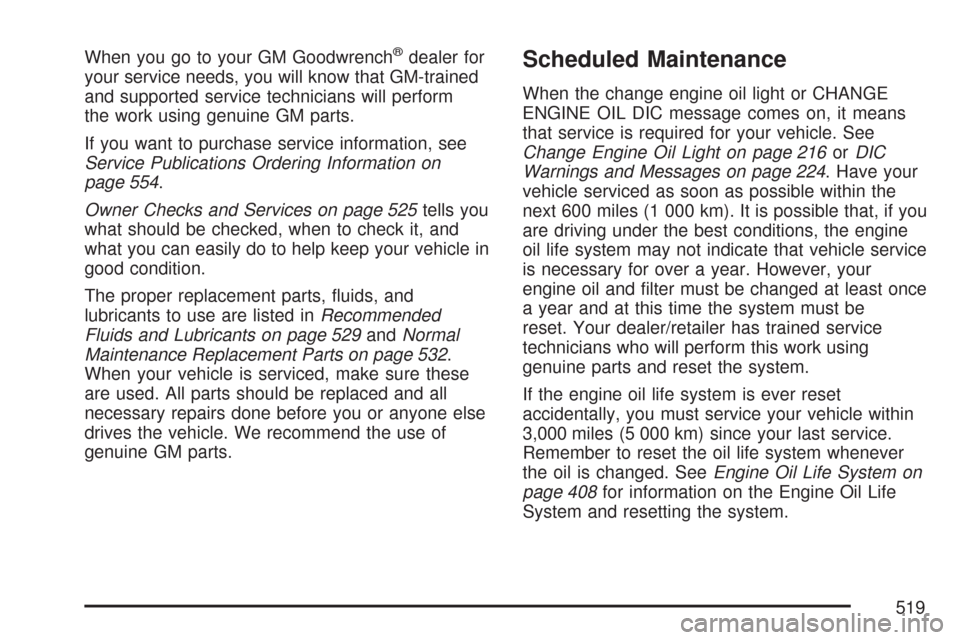
When you go to your GM Goodwrench®dealer for
your service needs, you will know that GM-trained
and supported service technicians will perform
the work using genuine GM parts.
If you want to purchase service information, see
Service Publications Ordering Information on
page 554.
Owner Checks and Services on page 525tells you
what should be checked, when to check it, and
what you can easily do to help keep your vehicle in
good condition.
The proper replacement parts, �uids, and
lubricants to use are listed inRecommended
Fluids and Lubricants on page 529andNormal
Maintenance Replacement Parts on page 532.
When your vehicle is serviced, make sure these
are used. All parts should be replaced and all
necessary repairs done before you or anyone else
drives the vehicle. We recommend the use of
genuine GM parts.Scheduled Maintenance
When the change engine oil light or CHANGE
ENGINE OIL DIC message comes on, it means
that service is required for your vehicle. See
Change Engine Oil Light on page 216orDIC
Warnings and Messages on page 224. Have your
vehicle serviced as soon as possible within the
next 600 miles (1 000 km). It is possible that, if you
are driving under the best conditions, the engine
oil life system may not indicate that vehicle service
is necessary for over a year. However, your
engine oil and �lter must be changed at least once
a year and at this time the system must be
reset. Your dealer/retailer has trained service
technicians who will perform this work using
genuine parts and reset the system.
If the engine oil life system is ever reset
accidentally, you must service your vehicle within
3,000 miles (5 000 km) since your last service.
Remember to reset the oil life system whenever
the oil is changed. SeeEngine Oil Life System on
page 408for information on the Engine Oil Life
System and resetting the system.
519